As we stayed hunkered down for much of 2020, Wine Lister was working on a new interactive tool for its website users: the Vintage Chart. Adding further breadth to our rating and information hub, this new feature allows side-by-side comparisons of top vintages from various countries, regions, and appellations.
See the example of Côte de Nuits reds below for some of the best of Burgundy’s back vintages, or explore the Vintage Chart for yourself here.
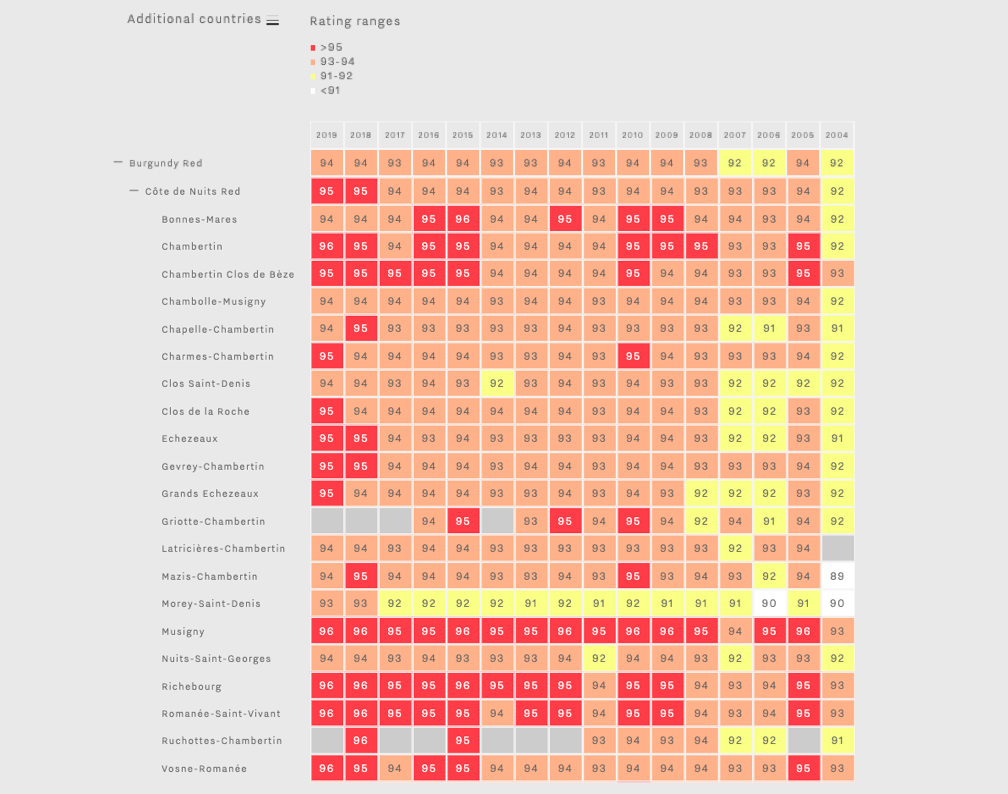
The Vintage Chart above compares the past 16 vintages of Côte de Nuits reds by WL score, based on the average WL scores of the top-performing wines in each “line”.
Informed by the latest available scores from two of Wine Lister’s partner critics, Jancis Robinson, Jasper Morris, and Neal Martin (Vinous) a look at the 2019 column reveals the success of Musigny, Richebourg, Romanée-Saint-Vivant, and Vosne-Romanée in the most recent vintage currently being released en primeur. The top-performing wines across the four appellations achieve an average WL score of 96, followed closely behind by Chambertin, Chambertin Clos de Bèze, Charmes-Chambertin, Clos de la Roche, Echezeaux, Gevrey-Chambertin, and Grands Echezeaux all gaining an average WL score of 95 in 2019.
Using the horizontal scroll to explore back vintages, one can see that Musigny is the most consistently high-scoring Côte de Nuits red appellation, with its top wines achieving an average WL score of 95 and above in the 15 vintages since 2004.
Click here to explore the Vintage Chart for yourself, or watch our video demonstration to find out how to get the most out of this new interactive tool here.
Wine Lister Pro members have access to a more extensive Vintage Chart, which integrates our holistic 360° rating system to visualise the average scores in the Economics and Quality categories, as well as by overall WL Pro score (which also takes into account a wine’s Brand clout). Log in to your account to view the Pro Vintage Chart here, or find out more about the Pro subscription here.
The end of 2020 is perhaps reason enough to pop open a bottle of champagne. With Christmas and New Year around the corner, Wine Lister has compiled a list of 21 Champagne MUST BUYs to enjoy over the last days of this year, and into 2021. Whether you have a penchant for discovering grower champagnes, or prefer to relish in those the top Grandes Maisons have to offer; whether you enjoy the purity of a Blanc de Blancs, the balance of an assemblage, or the opulence of a Blanc de Noirs, the selection of vintage champagnes below is sure to offer guidance for any preferred style.
Find out more about our 21 Champagne MUST BUYs for 2021 below.
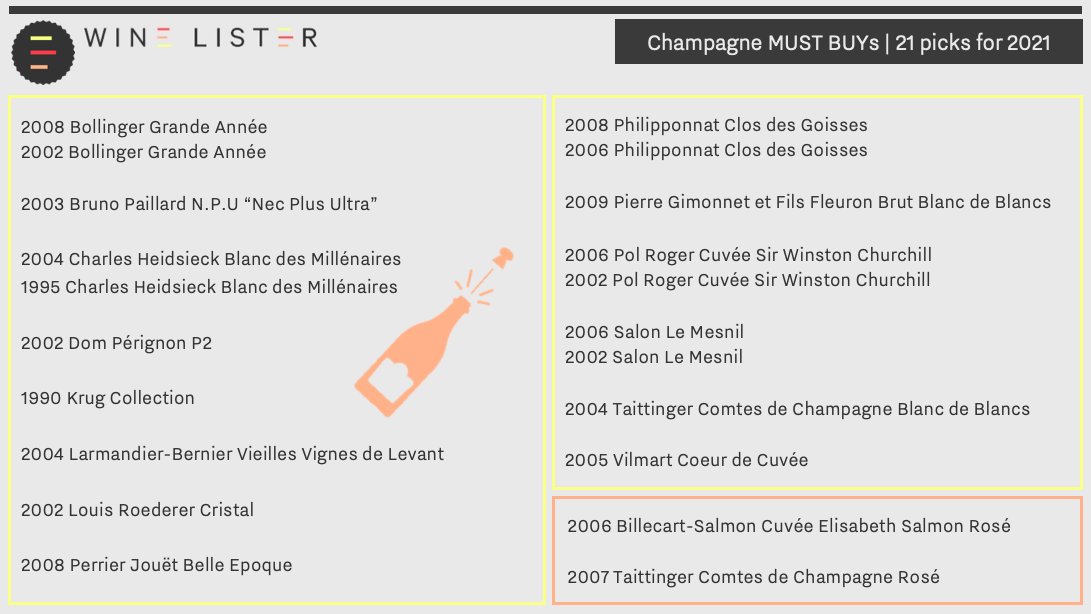
Long-established house, Charles Heidsieck, is represented in our MUST BUY selection with two vintages of its Blanc des Millénaires – 1995 and 2004. The wine is so-named to reflect its high ageing potential, and is only created in vintages worthy of the label (since its inception, just five have been made). The 2004 achieves a WL score of 95, and is praised by Wine Lister partner critic, Jancis Robinson, as having “sheer confidence, appeal and completeness”. Earning one more WL point, the 1995 shows “just how compelling this often-overlooked vintage can be”, according to Wine Lister partner critic, Antonio Galloni (Vinous). Both vintages can be bought by the case of six in-bond from Cru World Wine.
Also the crown jewel of its own house, Perrier-Jouët’s Belle Epoque carries its own portion of history within its name, referencing the Art Nouveau movement of the early 1900s. The prestige bottling can be appreciated on the inside and out, particularly in the spectacular 2008 vintage. Wine Lister tasted it recently, and found it to have a concentrated nose of white peaches, brioche, and a hint of honeysuckle, with brilliant tension on the palate. 2008 Belle Epoque is available to purchase by the bottle from Lay & Wheeler, for £129 (in-bond).
A further two MUST BUYs hail from the boutique house, Philipponnat Clos des Goisses. The 5.5-hectare Clos de Goisses parcel is the oldest and steepest “Clos” in champagne. The 2006 and 2008 vintages of this single-vineyard cuvée both receive a WL score of 96. Jancis Robinson praises both vintages, writing that the 2006 “positively screams for attention”, while the 2008 is “explosive… like a firework on the palate”. They can both be acquired in-bond from Bordeaux Index.
Included in our 21 MUST BUY champagnes are two grower offerings lying outside of champagne’s more widely-declared vintages. Notorious for its killer heatwave, 2003 is not well-appreciated among the champenois. Bruno Paillard’s 2003 N.P.U. challenges this perception, offering a “dancing” palette of “open and floral notes” according to Jancis Robinson. Acknowledging that the vintage was hugely criticised, Paillard says that for him, “it’s a great vintage”. Another elusive grower champagne rounds off our list. Jancis Robinson hailed the 2005 Vilmart Coeur de Cuvée as “a wine to wallow in”, praising its complexity and “refreshing finish”.
Also featured in the list of 21 Champagne MUST BUYs for 2021 are: 2006 Billecart-Salmon Cuvée Elisabeth Salmon Rosé, 2008 Bollinger Grande Année, 2002 Bollinger Grande Année, 2002 Dom Pérignon P2, 1990 Krug Collection, 2004 Larmandier-Bernier Vieilles Vignes de Levant, 2000 Louis Roederer Cristal, 2009 Pierre Gimonnet et Fils Fleuron Brut Blanc de Blancs, 2006 Pol Roger Cuvée Sir Winston Churchill, 2002 Pol Roger Cuvée Sir Winston Churchill, 2006 Salon Le Mesnil, 2002 Salon Le Mesnil, 2004 Taittinger Comtes de Champagne Blanc de Blancs, and 2007 Taittinger Comtes de Champagne Rosé
As 2020 draws to a close, Wine Lister has compiled a report celebrating the top-performing wines and producers within a series of categories over the past year. Using our axes of Quality, Brand, and Economics, and the several factors that constitute these values, we have created seven leagues that paint a panoramic view of some of the world’s best wines, ranked within their areas of excellence.
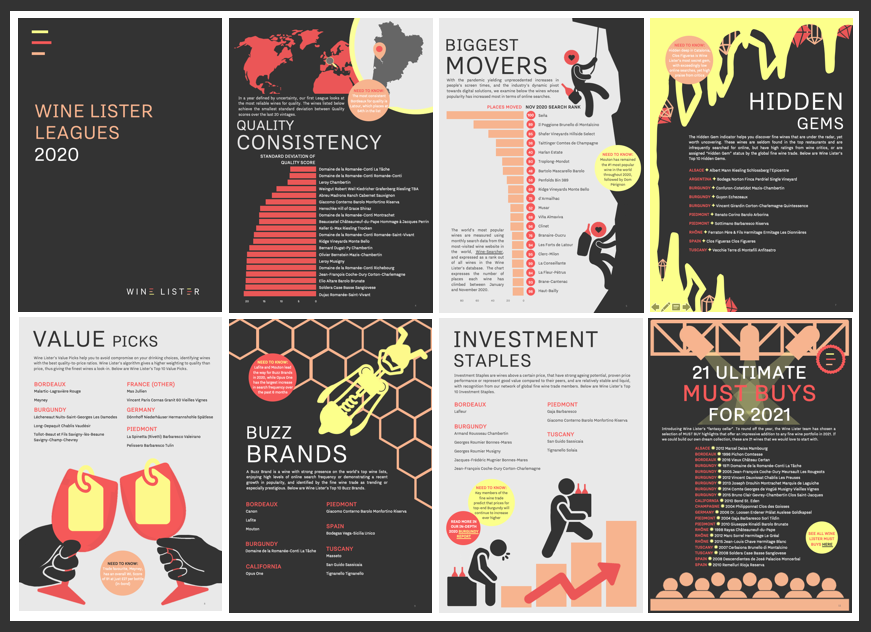
Wine Lister’s 2020 Leagues include rankings of Quality Consistency (wines that show the smallest standard deviation between Quality scores over the last 20 vintages), and Biggest Movers (wines whose popularity has increased most in terms of online searches over the past year). Our team has also put together its top-10 wines per Wine Lister Indicator, revealing our recommendations for Hidden Gems, Value Picks, Buzz Brands, and Investment Staples.
We end the Leagues with a list of 21 Ultimate MUST BUYs for 2021, compiling a selection of MUST BUY highlights hand-picked by our fine wine experts, that offer an impressive addition to any fine wine portfolio in 2021. These are some of the picks that would feature in Wine Lister’s “fantasy cellar”.
Download your free copy of Wine Lister’s 2020 Leagues here.
If ever there is a time for claret, it’s Christmas. While Bordeaux generally provides excellent quality for its prices relative to other regions all year round, it is an especially good source for festive bottles with a bit of age. Below Wine Lister offers one MUST BUY under £100 per Bordeaux appellation – a selection that promises to please with your Christmas meal.
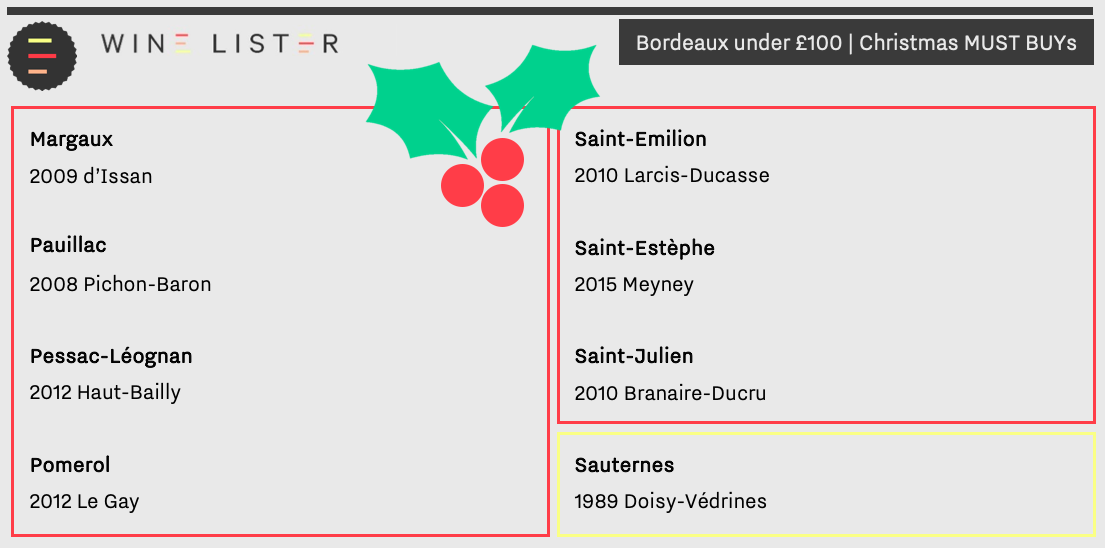
Aside from its lustrous gold label providing an appropriate centrepiece to any festive feast, d’Issan 2009 offers good value for its appellation, earning a WL score of 93 at £56 per bottle (in-bond). Château owner, Emmanuel Cruse, is also the “Grand Maître” of the Commanderie du Bontemps – a Bordeaux organisation uniting trade members in the preservation of Bordeaux’s excellent quality reputation. D’Issan embodies the values of its maker, exemplifying the traditional claret style with added Margaux elegance. It is available to purchase by the case of 12 from Nickolls and Perks.
Pauillac powerhouse Pichon-Baron 2008 is described by Wine Lister partner critic, Neal Martin (Vinous), as one of the property’s “overachievers in recent years”. Often noted for being one of the most concentrated wines of the vintage in its appellation and beyond, Martin writes that the 2008 is “full of tension and energy […] delivering real brightness and vivacity on the finish”. At £90 per bottle (in-bond), it is the most expensive wine featured in this article, however, its Second Growth status and an abundance of critics’ praise make it worthy of consideration. Pichon-Baron 2008 can be acquired by the case from Lay & Wheeler.
A top-quality substitute to some of Haut-Bailly’s more costly back vintages, the 2012 achieves the property’s second-best WL score ever, as well as second place for quality among Pessac-Léognan reds for the vintage. Wine Lister partner critic, Antonio Galloni (Vinous), states that “the decision to lower temperatures in fermentation and go for a soft, gentle extraction, along with strict selection has paid off big time” in 2012, revealing notes of “dark raspberries, mint, crushed flowers, spices and rose petals”. Haut-Bailly 2012 is just entering its drinking window, and can be bought from Cru Wine.
Finding value on Bordeaux’s right bank can be trickier, particularly in Pomerol. Le Gay 2012 nonetheless offers excellent quality (WL 94) for the relatively reasonable price of £61 per bottle (in-bond). Wine Lister partner critic, Jancis Robinson, notes that it reaps “real Pomerol reward in terms of concentration”, offering a “very well-integrated nose […] sweet and focused”. In neighbouring Saint-Emilion, Larcis-Ducasse 2010 is described as “simply stunning” by Antonio Galloni, who notes “violet, lavender, graphite and menthol” that “give the 2010 its energy and tension”. It gains a WL score of 94, at £87 per bottle (in-bond). Both of these right bank picks can be purchased from Cult Wines.
Achieving Value Pick status, Saint-Estèphe’s Meyney 2015 has a WL score of 93 at £25 per bottle (in-bond), providing a veritable steal for your Christmas meal. After sampling at the annual Southwold Bordeaux tasting, Neal Martin writes that it “was the shock of this blind tasting – in a positive sense […] I thought it might be Montrose but it turned out to be Meyney. Chapeau!” Though the 2015 could benefit from a few more years of ageing, it is a brilliant gift option for your more patient guests, and can be acquired from Goedhuis & Co.
Saint-Julien star, Branaire-Ducru’s 2010 vintage was described as “dancing” by Jancis Robinson. Neal Martin’s tasting note suggests a wine of complexity: “a lovely mélange of red and black fruit, hints of dried blood and autumn leaves suggesting that this is moving into its secondary phase”. With a WL score of 93, Branaire-Ducru 2010 can be purchased by the case of 12 from Farr Vintners for £52.50 per bottle (in-bond).
For a sweet end to your Christmas meal, Wine Lister suggests Doisy-Védrines 1989. With 30 years of ageing under its belt, it achieves a WL score of 94 – the château’s highest ever. It is described by Neal Martin as boasting “a captivating bouquet of gorgeous wild honey, Seville orange marmalade, fig jam and light lemongrass scents”. He adds, “it is simply everything you desire in a sweet Bordeaux”. Purchase Doisy-Védrines 1989 by the bottle from Hedonism Wines for £62.80 (in-bond).
Top chefs are often interrogated on their favourite dishes to cook at home, actors on their favourite films, writers on their favourite books – Wine Lister has sought out the ultimate drinking inspiration for special occasions, interviewing a handful of top wine producers on their favourite wines.
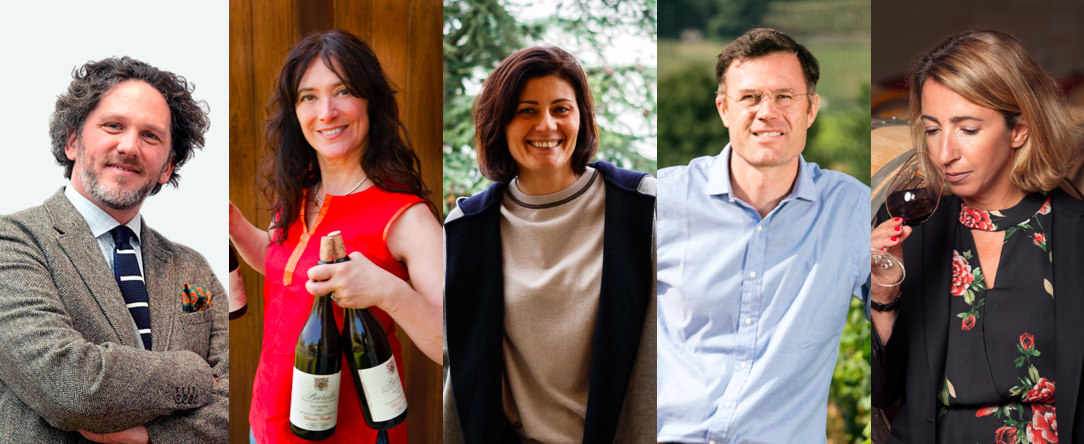 From left to right: Axel Heinz, Chiara Boschis, Gaia Gaja, Jacques Devauges, and Marielle Cazaux
From left to right: Axel Heinz, Chiara Boschis, Gaia Gaja, Jacques Devauges, and Marielle Cazaux
Axel Heinz – Ornellaia
“It’s certainly the most difficult question to answer for a winemaker”, Axel begins. Born in Germany, and spending his early career in Bordeaux before joining Ornellaia, his choice, once we twisted his arm, sits far from his professional vinous journey. “It would be a white, from my favourite Grand Cru in Burgundy: Corton Charlemagne”, he confesses, explaining that for him, these wines combine the structure and power of a red wine, with “the vibrancy, fragrance, and minerality that one can only find in great whites”. Admiring its capacity for a faithful expression of terroir, and display of true personal signature, he cites Coche-Dury as his go-to producer.
Chiara Boschis – E.Pira e Figli
With Barolo in her blood (her relatives founded the historic Giacomo Borgogno estate), it is not unusual that Chiara Boschis’ favourite wine should hail from this same noble Italian region. She tells us that she understood from a young age “the privilege to be born in such a generous land”, for which her parents, and the people around her had “great love and respect”. After years in the cellar at E.Pira, she too became “entirely captured by the magic of Barolo”. Chiara’s top choice is therefore a Barolo from the Mosconi vineyard for its “complexity and depth”, Cannubi for its “elegance”, and the vineyards of Via Nuova for their “diversity”.
Gaia Gaja – Gaja
While paying homage to her family’s past through her own wines, fifth generation winemaker, Gaia Gaja also has one eye on the future. Her favourite wine, from rising star appellation Mount Etna, Sicily, is Graci’s Etna Rosso Arcuria. The wine is made from one of the latest ripening European varieties, Nerello Mascalese, in one of the highest vineyards in Europe. She discovered it after “becoming close friends with Alberto Graci and his family”, often visiting them in Etna. Gaia explains that “the contrasts between its vibrancy, freshness, and warmth, as well as its perfume and smoky minerality”, remind her of “the snow and the fire of Etna”. Comparing it to Nebbiolo, she believes the grape has “intriguing personality, a strong identity of place, and a medium body that makes it versatile and easy to drink”.
Jacques Devauges – Clos des Lambrays
Moving from Clos de Tart to Clos des Lambrays last year, Jacques Devauges’ top wine of all-time was born close to home. He tells us that Comte Georges de Vogüé’s Musigny catalysed his passion for wine. Sampling the 1971 and 1978 as a teenager, he was “struck” by both, despite knowing very little about wine at that point. Jacques believes Vogüé’s Musigny shows “the signature of the Grand Vin”, to impress “not only the wine geek, or the collector, but everyone, even those who don’t know what makes a good wine”. Describing what “was almost a shock”, he notes that the “level of perfume on the nose was almost like a perfume you can put on your skin”, while the palate was “soft and delicate”.
Marielle Cazaux – La Conseillante
Joining La Conseillante from neighbouring Petit-Village in 2015, Marielle Cazaux tells us that if she had to pick a favourite wine, it would be Ridge Vineyards Monte Bello, because she “has so many special memories with this wine”. As an intern at Ridge in 2001, she had the chance to taste several vintages with the legendary Paul Draper, whom she calls “one of the most gifted winemakers of the US”. Marielle considers Monte Bello a “wine with extraordinary finesse”, and “a total sense of harmony”. Describing its notes of “black pepper, lavender, mocha, liquorice, and dried flowers”, she observes that it is “perhaps one of the most “Bordeaux” style wines in California”.
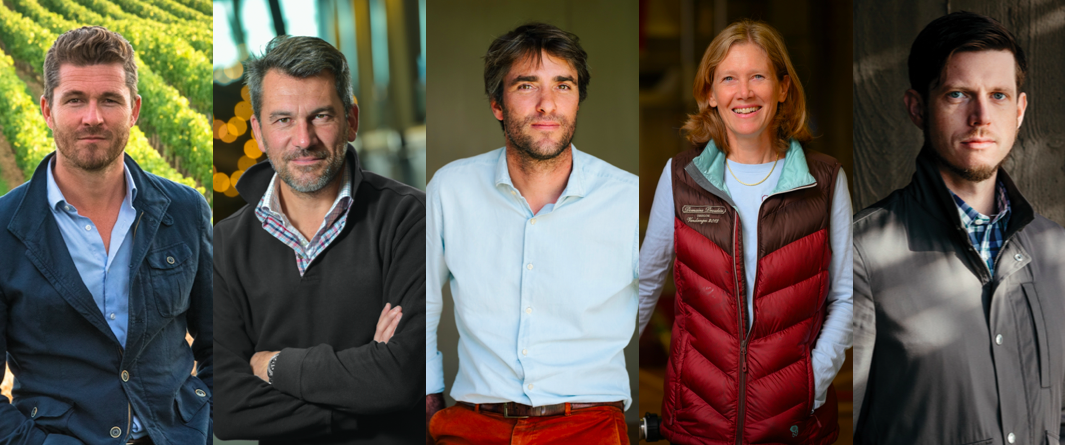 From left, Nicolas Audebert, Nicolas Glumineau, Pierre-Olivier Clouet, Veronique Boss Drouhin, and Will Harlan
From left, Nicolas Audebert, Nicolas Glumineau, Pierre-Olivier Clouet, Veronique Boss Drouhin, and Will Harlan
Nicolas Audebert – Rauzan-Ségla, Canon, and Berliquet
With some of the world’s most prestigious wineries under his belt (Terrazas de Los Andes, Cheval des Andes, Moët & Chandon, Krug, Veuve Clicquot), Nicolas echoes Axel Heinz in attempting to pick his favourite wine: “it’s impossible to answer. It’s like music – endless, initiatory, and progressive”. He instead recommends a wine from his friend, winemaker Andrea Felluga, with whom he “shares wine at simple, festive tables with lots of laughter”. He tells Wine Lister that Felluga’s wine, Livio Felluga Terre Alte “is a great white from Friuli” – a “land of contrast between the sunny and singing soul of Italy and the Alpine foothills, austere and cool”. Made from a blend of Friulano, Sauvignon Blanc, and Pinot Blanc, the Terre Alte is, according to Nicolas, like Felluga – “happy and lively”.
Nicolas Glumineau – Pichon Comtesse
On the subject of his favourite wine, Nicolas Glumineau (previously of Haut-Brion, Margaux, and Montrose), tells us that there are so many wines he could note – “Rayas 1990, E. Guigal La Mouline 1976, Cristal 1996, Trotanoy 2009, Diamond Creek Red Rock Terrace 2015”. White Burgundy legend, Coche-Dury, nonetheless gets another vote from Nicolas (on top of praise from Axel Heinz) as he reminisces trying the Meursault Caillerets 2006 for the first time in London, and being “choked, speechless, and moved by such perfection”. He describes the “delicacy of its white flower aromas and the elegance of its mineral and endless finish”, and recalls the feeling “that the world has stopped turning and that time has been suspended”.
Pierre-Olivier Clouet – Cheval Blanc
Echoing the sentiment of several of his peers, Pierre-Olivier Clouet (who has been at Cheval Blanc for 16 years), tells us that “it is impossible to choose just one wine”, because “like wine, the palate of the taster is constantly evolving”. Pierre-Olivier nonetheless notes his current favourite is “Mas Jullien – a wine that fully expresses the identity of the place where it is made, and injects the touch of balance and freshness that characterises all the great wines of the world”. He recalls that the last time he tasted the Languedoc red – a blend of Syrah, Carignan, and Mourvèdre – was with his team, on the last day of Cheval Blanc’s 2020 harvest.
Veronique Boss Drouhin – Joseph Drouhin
Fourth-generation winemaker, Veronique Boss Drouhin tells us that a wine she particularly enjoys was introduced to her by her close friend, Christine Vernay, daughter of the late Georges Vernay (praised for his key role in the survival of the Condrieu appellation). Veronique recalls Vernay opening a bottle of Georges Vernay Condrieu Coteau de Vernon, and being enchanted by its “aromatics, jumping out of the glass – unique, fragrant, and complex”, and a palate that was “powerful, voluptuous, and round, but with acidity to balance it” – a rarity for Viognier. She also cites Georges & Christophe Roumier’s Chambolle-Musigny Les Amoureuses as one of her favourites, adding, “Christophe’s [wine] is one of the nicest, purest, more elegant expressions of Pinot”.
Will Harlan – Promontory
Leading Harlan Estates‘ second-generation venture, Will Harlan explains to us that while he cannot choose a favourite, Jacques-Frederic Mugnier’s Musigny 2001 is a wine that he believes to “belong among the finest”. Will recalls coming across the bottle while “travelling with colleagues through Copenhagen a few years ago”, and as there hadn’t been a correct time to open it, the bottle joined them “on a course through Germany to Switzerland”. Having finally found an appropriate evening in Zurich to open it, “by the lake — the first bit of rest since the trip began”, he was “drawn in, as each feature of the wine, with a humble nobility, felt very naturally and confidently in its place”. Will notes it was a “wine that was singular and true”, that “would mark a memorable evening of our travels and in our friendships”.
The first of the Burgundy 2019 en primeur releases began this month, reigniting conversation of last year’s growing season, and its subsequent offerings. Wine Lister has spoken to several key Burgundy producers, and has sampled the 2019s from leading négociant, Louis Jadot, to get a better picture of this promising vintage.
Burgundy’s 2019 growing season was marked by a notably hot and dry summer, resulting in wines of extreme concentration. Due to a combination of spring frost, uneven flowering, and summer drought across many sites, yields in 2019 are significantly lower than average.
 A line-up from Louis Jadot’s 2019 en primeur tasting, organised by Hatch Mansfield at Vagabond, Monument on the 3rd of November 2020
A line-up from Louis Jadot’s 2019 en primeur tasting, organised by Hatch Mansfield at Vagabond, Monument on the 3rd of November 2020
Sourcing grapes from across the region, including its own holdings in some of Burgundy’s most prized plots (e.g. Chapelle Chambertin, Clos Vougeot, and Vosne-Romanée), Louis Jadot’s production in 2019 is down 50% for Chardonnay, and 30% for Pinot Noir. A cool and windy spring caused millerandage across Jadot’s sites, leading to many of the smaller, unripe berries being discarded. Warm temperatures in 2019 meant that grapes had high natural sugar levels, and correspondingly high alcohol across the region. Deputy General Manager, Thibault Gagey, tells us that several Louis Jadot wines are approaching 14 degrees in 2019, however, they nonetheless offer “good acidity, so they are powerful but balanced”, and there “isn’t a feeling of high alcohol”.
Wine Lister agrees whole-heartedly, and was particularly impressed by the quality of the whites. The Chablis Blanchot was “pure and lithe with an already-sumptuous texture”, while the Chassagne Montrachet Morgeot Clos de la Chapelle offered a delightful nose of “honey, truffle, and brioche”, with “rich citrus” on the palate. For reds, Wine Lister enjoyed the “complex and earth-toned” Clos Saint-Denis, and the “powerful but poised” Gevrey-Chambertin Clos Saint-Jacques. Gagey informs us that he is indeed “very proud of the 2019s”, and is “confident that it will be a good vintage”.
Across the Côte de Beaune, harvests were small in 2019. Arnaud Ente tells us that his namesake domaine saw “a spell of spring frost”, which caused significant damage and loss of yield, and “uneven weather patterns during flowering”, caused coulure and millerandage. The summer was mostly hot and dry, causing hydraulic stress to the vines, but “20-30mm of rainfall in late August” helped to unblock phenolic maturation, and allow the grapes to reach “impressive levels of maturity while maintaining good sugar levels, and also a very lovely acidity”. Ente notes that his 2019s have achieved “extraordinary balance, due to the acidity in the grapes developing slowly”. The vintage is of “enormous potential”, if down 20% on an average year in terms of volume.
Domaine Jean-Noël Gagnard similarly experienced significant frost in 2019; the principal cause of its small harvest. Winemaker Caroline Lestimé echoes the experience of “millerandage followed by hydraulic stress on the vines during the summer drought”, resulting in “small, but thankfully exceedingly concentrated berries”. Due to the two extremes of conditions throughout the season, Lestimé analysed the sugar / acid balance frequently near to harvest, so as to pick the optimum window for picking. Once again, quality here is likely a triumph, but Lestimé adds that “Jean-Noël Gagnard has not seen such a small harvest since 1999”.
Guillaume d’Angerville tells us that in Volnay, “frost risk was on everyone’s mind”, however, “dry and windy conditions helped to avoid frost damage” across Marquis d’Angerville’s plots. Water and heat stress in summer was a problem here too, “stopping the plant’s evolution, and veraison was delayed as a result”. He similarly explains that “selecting the correct harvest date proved difficult”, in part due to the “heterogenous grape maturation”, however in the end, “the entire range benefitted from the perfect maturity of the grapes”, despite yields being down 20-30% on the average year. He tells us that his 2019s are “succulent and full of energy”, without being “jammy” from such a hot year, and therefore providing “another successful vintage ending in 9”.
Akin to Louis Jadot, Winemaker Jean-Nicolas Méo tells us that Méo-Camuzet’s 2019s are “well-ripened”, with “fairly high alcohol levels, around 14 degrees”. He states that there is nonetheless “a nice acidity to start”, which provides the wines “a good freshness and a certain structure”, as well as lengthy ageing capacity. Echoing d’Angerville’s sentiment on the success of 9s, Méo foresees “an evolution of this vintage like the 2009: rich and greedy at first, then gradually closing, to emerge in a decade more tense and structured than suggested today”.
Despite the significantly reduced volumes in 2019, the quality of Burgundy’s latest vintage release clearly suggests a long and promising future ahead. The combination of these two factors will surely see demand outweigh supply for en primeur once again. For more guidance on buying Burgundy 2019 en primeur, and essential analysis to inform your wider Burgundy investment decisions, purchase our in-depth Burgundy study here.
Wine Lister’s recent in-depth Burgundy study considers the much-contended topic of the region’s rising prices, providing additional information for those planning on purchasing Burgundy 2019 en primeur over the coming months.
Below we examine the current distribution of prices of the 175 wines featured in the study, compared to the same wines two years ago. While 5% of wines were priced above £3,000 two years ago, a substantial 11% are today.
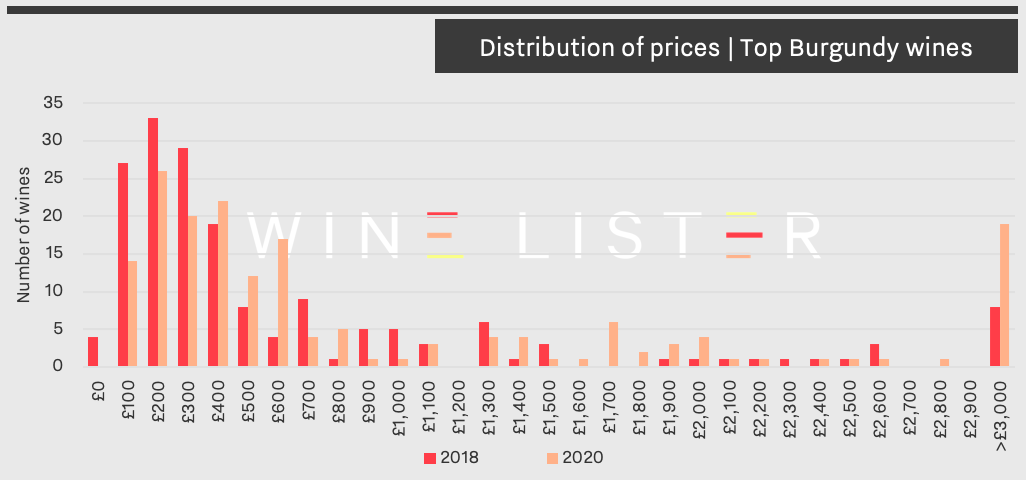
The graph above reveals a significant shift towards the higher end of the price scale, with multiple Burgundy wines previously priced between £1,900 and £2,700 now over £3,000. This comprises Comte Liger-Belair La Romanée, d’Auvenay’s Mazis-Chambertin and Bonnes-Mares, Domaine de la Romanée-Conti La Tâche, Jean-François Coche-Dury Corton-Charlemagne, and Leroy’s Richebourg, Romanée-Saint-Vivant, Clos de la Roche, Corton-Charlemagne, and Latricières-Chambertin.
Alongside the figures, feeling from Wine Lister’s recent Founding Member survey confirmed that Burgundy’s seemingly boundless prices are a concern, with over half of respondents voicing apprehensions on the topic. The most common sentiment is nonetheless that little will change for wines at the very top end, and that their prices will continue to climb, as demand continues to outweigh supply significantly. One specialist merchant in the Asian market informed us that they indeed foresee “Burgundy prices heading higher at the top end”, and that they “don’t see demand slowing despite the economic issues.”
The polarised prices illustrated in the graph are echoed by the trade, who cite a phenomenon of divergence between the top-end wines, and those at mid-range or entry-level. One respondent noted “an oversupply of generic and village Burgundy”, with another predicting that “when the smoke clears, all that remains will be Bourgogne Rouge/Blanc and the crown jewels, with no market in between”.
Despite the geopolitical context of the past two years, the buzz surrounding Burgundy remains strong, and competition will be hot for accessing the best wines of the 2019 vintage, particularly given its reduced production volume.
Visit the Analysis page to purchase Wine Lister’s in-depth 2020 Burgundy study, or download it using your Pro subscription here (available in both English and French).
Before the bulk of Burgundy en primeur 2019s are released onto the market, Wine Lister has published its second in-depth Burgundy study.
Below we explore the complex relationship between the region’s price performance and its popularity growth over the past two years, informing your investment decisions over the coming months.
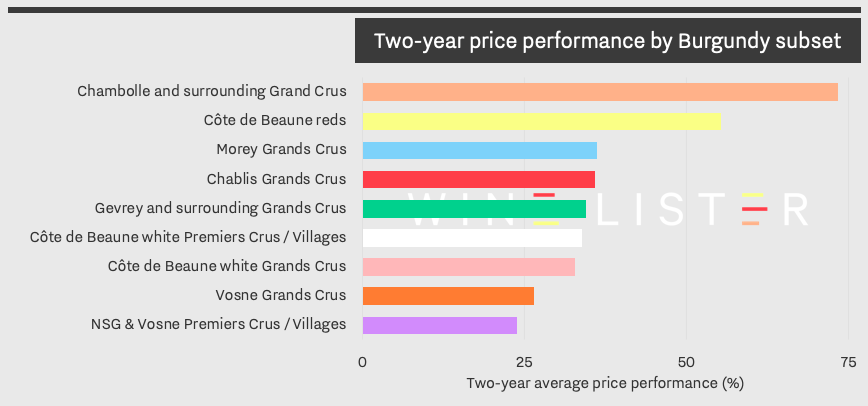 The two-year price performance of a basket of 175 Burgundy wines (the same wines featured in our previous study on the region in 2018), based on the last 30 vintages. Price data partner: Wine Owners.
The two-year price performance of a basket of 175 Burgundy wines (the same wines featured in our previous study on the region in 2018), based on the last 30 vintages. Price data partner: Wine Owners.
As shown in the chart above, Chambolle and its surrounding sites lead in the price performance of Burgundy Grand Crus, followed by wines hailing from its northerly neighbour, Morey-Saint-Denis. The notorious sub-set of Grand Crus from around Vosne – home of legendary Richebourg, La Tâche, Echezeaux, and Romanée-Conti – has seen slower price performance, which is matched with lower popularity growth (see below).
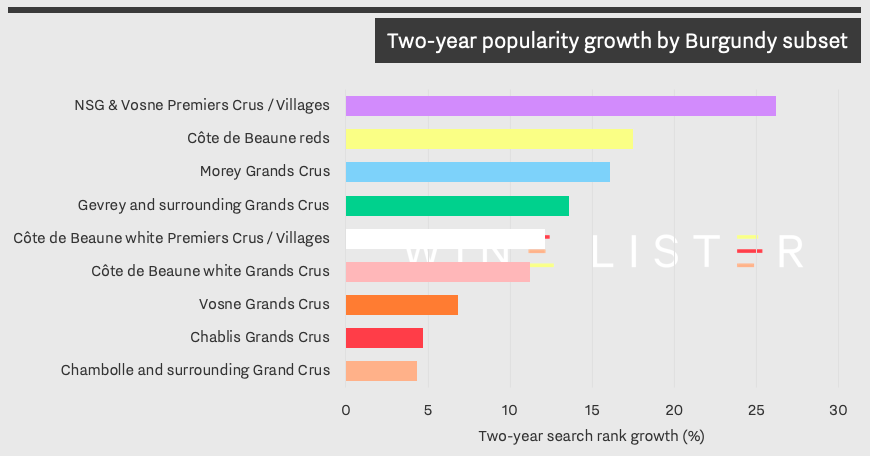 The two-year popularity growth of each Burgundy subset. Popularity data partner: Wine-Searcher.
The two-year popularity growth of each Burgundy subset. Popularity data partner: Wine-Searcher.
Though Chambolle and its surrounding Grand Crus have excelled in two-year price growth, consumer interest in the wines of this subset increased the least. Following similarly this opposing relationship between the two data sets, Nuits-Saint-Georges / Vosne Premiers Crus and Village wines gained the most popularity over the last two years by a large margin, while the subset’s price performance trails behind in last place.
A growing interest in lower-priced wines from Burgundy is further explored through trends identified by key members of the international fine wine trade in Wine Lister’s report. Producers such as Arnoux-Lachaux and Georges Mugneret-Gibourg are well worth looking out for when buying Burgundy en primeur for drinking in several years’ time.
Visit the Analysis page to purchase Wine Lister’s in-depth 2020 Burgundy study, or download it using your Pro subscription here (available in both English and French).
Burgundy prices continue to rise, and top wines are becoming ever-harder to access – but must what goes up really come down?
Wine Lister has published its second in-depth Burgundy report, with contribution from partner critic and leading Burgundy expert, Jasper Morris. With insights from key fine wine trade players from across the globe, the report investigates the state of Burgundy compared to other major fine wine regions, and discusses projections for its future performance.
Please see our key findings below:
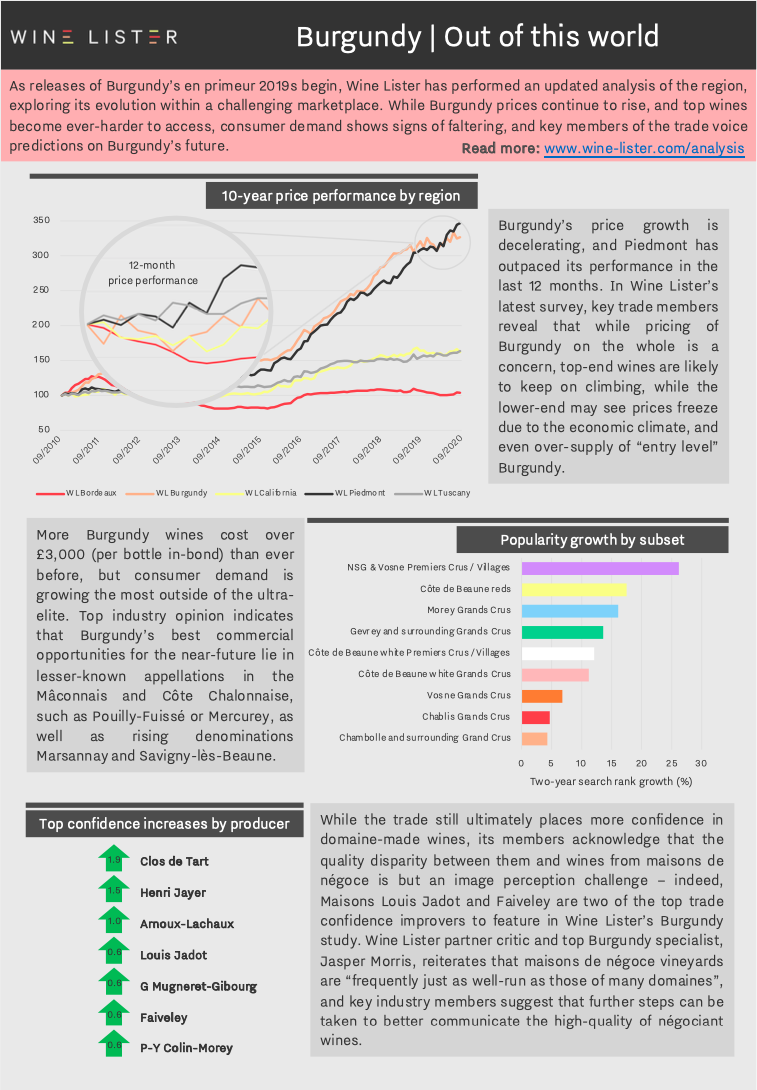
You can download the study digest in English here: Wine Lister Burgundy Study Digest 2020 or French here: Wine Lister Étude Bourgogne 2020 – Résultats Clés. The full report can be purchased on our Analysis page, while Pro subscribers can access their free copy here.
As much of Europe re-enters lockdown, the fine wine industry is once again adapting through the digital world. With many reliable retailers now running e-commerce platforms, there is simply no excuse not to purchase top-quality wine from the comfort of your own home. To help you get the best from your online buys, Wine Lister offers its top tips on avoiding compromise on your acquisitions, whether for drinking or for laying down in the cellar.
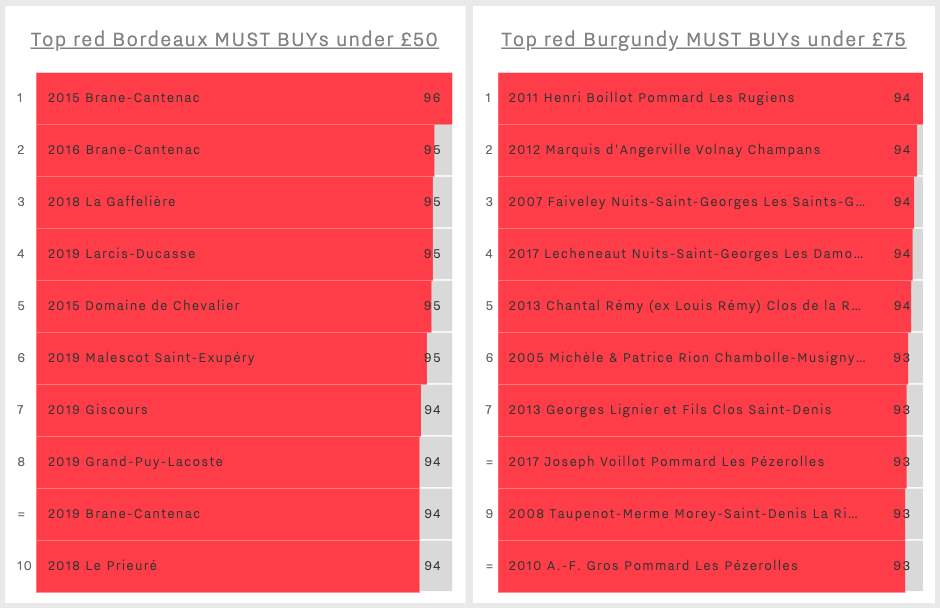
- Narrow down your drinking delights
With a plethora of brilliant bottles now available to purchase online, Wine Lister’s free tools provide a good place to start your decision journey, helping you to refine your browsing before you even begin. On top of our MUST BUY recommendation algorithm, our Wine Leagues provide top-10 lists of the best wines to source for given categories, be it appellation, price, or WL score (a quality measure comprising ratings from Wine Lister’s partner critics). Featured on the individual wine pages, Wine Lister’s drinking windows inform you of the best time to open your bottle, another key factor to consider when buying wine. The above sets of Wine Leagues reveal the top Bordeaux reds for under £50 (per bottle in-bond) and the top Burgundy reds for under £75.
- Elect an esteemed merchant
Whether you have determined what you want or not, it is crucial to buy only from trusted merchants. While pricing may vary, Wine Lister recommends sticking with reputable retailers to ensure top-notch provenance and delivery. The list of legitimate options is long, but we suggest the following (to name but a few): Berry Bros & Rudd, BI Fine Wines, Corney & Barrow, Goedhuis & Co, Justerini & Brooks, Lay & Wheeler, and Vinum Fine Wines.
- Refine through regional specialists
If your focus is on one region in particular, it can be beneficial to buy from specialist merchants. For example, Stannary Wines represent several top Burgundy producers, and Armit Wines are the agent for a number of leading Italian estates, providing dependable platforms for you to direct your search. It is useful to know which merchants are the primary UK importers of specific domains, for example, Justerini & Brooks represent Philipponnat Clos des Goisses, and Four Corners work with many top Californian fine wines.
For more industry insights and advice on which wines and regions to buy, sign up for Wine Lister’s free newsletter here.











